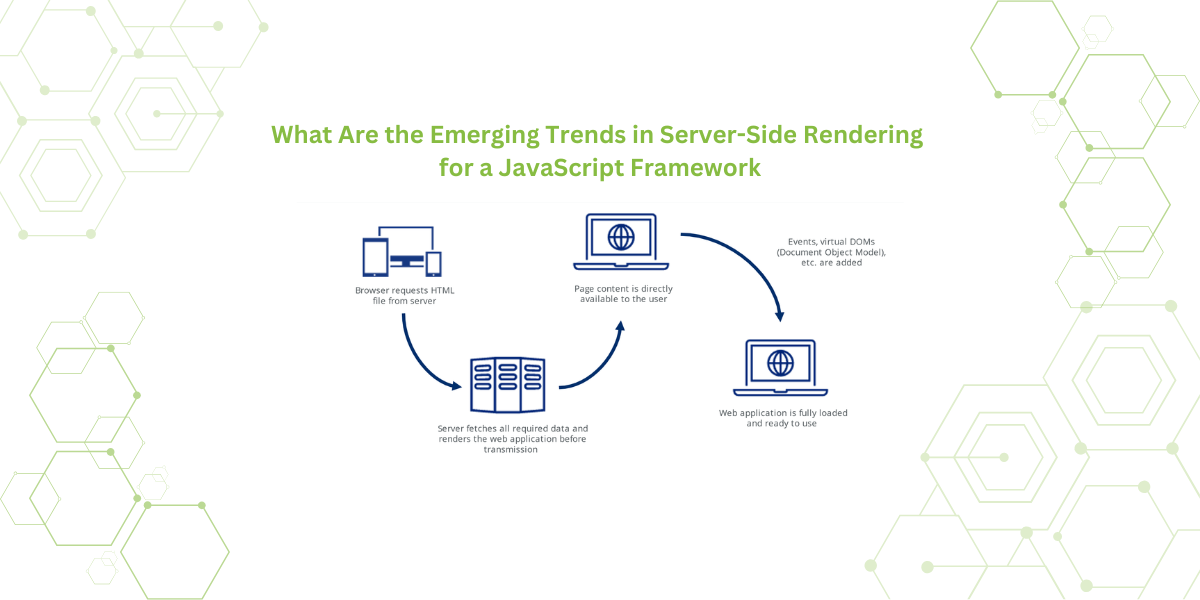What Are the Emerging Trends in Server-Side Rendering for a JavaScript Framework
Get a summary of this article:
Web development moves fast. Nobody has patience for slow-loading websites anymore. They want it to be quick, smooth, and ready to go. That’s where server side rendering (SSR) comes in. Instead of making the browser do all the heavy lifting with JavaScript, SSR delivers the page straight from the server, already built. It feels faster and helps with SEO, too.

This really comes in handy for single page web applications, which can get pretty sluggish when the front-end has too much going on. With React server-side rendering and tools like Next.js or Vue, it’s now way easier to build sites that are both fast and search engine-friendly. These JavaScript SSR frameworks also come with built-in tools for things like caching and optimizing content.
Some current trends in server side rendering React JS apps include tighter AI integration, smarter caching layers, and improved security during rendering. Developers are also using SSR in single page application JS setups and finding new ways to streamline performance in every single page application framework. Bottom line is, if you want your app to stand out today, staying on top of SSR trends is a smart move.
What Is Server-Side Rendering?
SSR (server-side rendering) means your server creates the webpage’s HTML before sending it to the browser. It’s like having your page ready-made instead of building it in the browser. Instead of downloading a blank page and then waiting for JavaScript to load and render content (as in CSR), SSR gives users a fully formed HTML page right away.
When someone visits a website, the server takes the request, generates the page, including all necessary data, and sends it to the browser. This helps with two big things: faster first contentful paint (FCP) and better search engine optimization (SEO).
So, what is server-side in this context? It’s the backend, where code runs on a server, often using a JavaScript SSR framework like Next.js or Nuxt.js.
Why is SSR good? Because it means your users get content faster. And for businesses, faster content means better engagement and higher conversion rates.
This is particularly important for single-page application JS setups, where traditional CSR approaches can cause long delays in loading content. SSR brings a balance by preloading critical HTML on the server and then hydrating it on the client.
Next.js is a great example – it lets you easily toggle between server-side rendering, static pages, or hybrid approaches, all while using React. Similarly, Sencha Ext JS offers support for SSR by providing stateful UI components and tight data binding, allowing for dynamic interaction after the page is rendered.
How Server-Side Rendering Works
Let’s walk through how SSR functions under the hood.
- A user visits a webpage.
- Instead of receiving a blank HTML shell and waiting for JavaScript to render the page, the server builds the HTML in real time.
- This fully rendered HTML is sent to the browser.
- Once the HTML loads, JavaScript takes over for interactivity, also known as hydration.
React handles server-side rendering through ReactDOMServer, which builds components on the server. But Next.js makes this way easier – it handles all the setup behind the scenes so you can just focus on building your app’s features and design.
Vue.js, through its SSR counterpart Nuxt.js, works similarly, building a complete Vue app on the server and sending that to the client. The result? Your single-page application framework behaves more like a traditional multi-page app at first, loading content instantly. Then, JavaScript kicks in to handle dynamic behavior and routing.
This hybrid model gives the best of both worlds: speed and flexibility.
Key Trends in Server-Side Rendering for JavaScript Frameworks
As demand for fast, scalable apps grows, so does the need for smarter SSR solutions. Here are the emerging trends reshaping SSR:
1. Increased Adoption of SSR
More developers are now choosing SSR over CSR, especially for SEO-heavy and content-first websites. Popular JavaScript framework options like Next.js (React), Nuxt.js (Vue.js), and Angular Universal are pushing SSR forward with built-in support and better tooling.
From e-commerce platforms to publishing websites, businesses are jumping on the SSR bandwagon to reduce load time and improve discoverability.
The adoption of SSR is also driving growth in the use of client-side frameworks that support hybrid rendering strategies, where SSR is used for initial loads, and CSR takes over for subsequent interactions.
2. Integration with AI and Machine Learning
Modern SSR isn’t just about static HTML anymore. It’s getting smarter.
AI and machine learning (ML) are now being used to predict user behavior. For example, AI models can analyze browsing patterns to determine which pages to pre-render or cache ahead of time. This enhances performance by reducing redundant rendering on the server.
Using AI also helps in dynamic content personalization. ML models can adjust page content based on the user’s location, behavior, or preferences, all server-side before the page even loads.
TensorFlow.js is often used in conjunction with SSR frameworks to create smart, interactive content that responds to real-world data.
3. Security Enhancements in SSR
With SSR growing popular, security risks like XSS and CSRF attacks are getting more attention. Developers are now carefully checking these vulnerabilities in server-rendered apps to keep them safe.
Modern SSR frameworks implement security by default. For example:
- Next.js escapes all props by default.
- Nuxt.js uses built-in server middleware to sanitize data.
Another growing trend is keeping sensitive operations entirely on the server. This minimizes the exposure of user data and adds an extra layer of protection against common attack vectors.
4. Framework-Specific Enhancements
Frameworks like React, Vue, and Angular are constantly updating their SSR features.
- Next.js has introduced middleware, Edge rendering, and React Server Components, which streamline data fetching and reduce JavaScript bloat.
- Nuxt 3, the latest version of Nuxt.js, supports native TypeScript and improves hydration strategies.
- Angular Universal now integrates with Firebase and other backend platforms for real-time SSR.
Even older frameworks like Ext JS are evolving with SSR capabilities to support large-scale, enterprise-grade apps. Their strong emphasis on component-driven development fits well with SSR strategies.
Challenges in Adopting Emerging SSR Trends
Server side rendering sounds great, and yes, it helps with speed and SEO. But let’s be honest, it’s not always easy. The newer SSR stuff can get confusing fast. It’s not something you just plug in and go. You’ve got to wrap your head around a lot before it all clicks.
Complexity in Adopting Advanced SSR Methods
Things like ISR and dynamic rendering sound cool, but it’s not always easy to pull off. Once you throw in real-time APIs and a bunch of JavaScript, things start to get messy. Suddenly, what looked simple becomes a lot harder to build—and even harder to debug. Development takes longer. Testing gets tougher. And yes, some of the issues that come up include:
- Race conditions during hydration
- Caching headaches due to poor invalidation logic
- Lag in loading personalized or user-specific content
To untangle these issues, you really need a good grip on how things work on both ends—server and client. Debugging isn’t just about scanning a few lines of code anymore; it’s about understanding the entire flow.
Balancing SSR with Client-Side Frameworks
It’s risky to make SSR work smoothly with tools like React and Vue. These tools are built for client-side stuff, so they expect to run in the browser. Trying to mix that with server-side rendering can feel awkward. You’ve got to juggle both worlds without breaking things. So, finding the sweet spot between server-side rendering and CSR is key:
- Lean too much into SSR, and your server starts to sweat
- Rely too much on CSR, and you’ll see SEO and page speed take a hit
That’s why a lot of developers go hybrid, use server side rendering for public content, and CSR for dashboards or logged-in experiences. It works, but yeah, your codebase gets more complex. More testing. More edge cases.
Infrastructure Challenges with Advanced SSR Trends
Throw AI personalization, edge delivery, and dynamic rendering into the mix, and your infrastructure needs to level up too. Suddenly, you’re dealing with:
- Serverless functions (like from Vercel or Netlify)
- Edge computing to get content closer to users
- Load balancing, Redis caching, or full-blown CDNs
All of this boosts performance but can also boost your cloud bill and your stress levels. If you don’t manage it well, even a solid JavaScript SSR framework can start feeling more like a burden than a bonus.
How Developers Can Stay Ahead
Staying sharp with server side rendering (SSR) isn’t just about reading the latest docs; it’s about getting your hands dirty and experimenting with what’s new. So if you’re aiming to stay ahead in 2025 (and beyond), here are some real-world ways to do it:
1. Use Modern JavaScript SSR Frameworks
Start by picking tools that make SSR feel less like rocket science. Frameworks like Next.js, Nuxt.js, and Remix support server-side rendering right out of the box. They save you time and headaches by handling most of the heavy lifting.
Need React server side rendering? Next.js is your go-to. It blends server side rendering React JS with static generation and client-side features, all in one place. These tools are built to handle everything from single page web applications to full-blown dynamic sites.
You also get to choose what fits each use case: go full SSR, keep it static, or use a client side framework when it makes sense.
2. Track Performance Like a Pro
Speed matters. And to improve it, you’ve got to measure it. Look at key Web Vitals like:
- Time to First Byte (TTFB)
- First Contentful Paint (FCP)
- Largest Contentful Paint (LCP)
Also, keep an eye on JavaScript bundle size and hydration time, especially if you’re building with a JavaScript SSR framework.
Ever wonder how to measure the time taken for rendering a React component? Tools like React Profiler or Lighthouse give you detailed breakdowns so you know exactly what’s slowing things down.
3. Try AI and Personalization
You don’t have to go full Skynet. Start small.
Use AI to optimize caching or track user behavior on busy pages. Once you’re comfy, try server side inference to personalize pages on the fly. This kind of smart server side rendering keeps SEO and speed in check while giving users a tailored experience.
4. Think Enterprise? Try Ext JS
If you’re building big, Ext JS has your back. It’s not just a single page application framework; it’s loaded with:
- Built-in routing
- Two-way data binding
- State management
- Full JavaScript UI component libraries
Need server side rendering React JS but also love Ext JS? You can hook it into SSR-ready platforms like Next.js using adapters or backend APIs. It’s got great docs, solid performance for complex apps, and a strong developer community to back you up.
Also Read: 10 Advanced JavaScript Tricks for Experienced Developers
5. Keep Learning and Build Stuff
Seriously, nothing beats hands-on experience. Stay active in dev spaces like GitHub, Stack Overflow, Reddit, or X (Twitter). Follow framework updates, Next.js, Nuxt.js, and other tools evolve fast.
Build side projects. Play with new SSR features. Break stuff. Fix it. That’s where the real learning happens.
In short, whether you’re deep into single page application JS, juggling server side rendering vs client side rendering, or just starting with JavaScript SSR frameworks, keep pushing forward. Try new things, measure what matters, and stay connected.
Because in the fast-moving world of web app development, staying curious is your biggest asset.
Conclusion
Let’s be real – SSR isn’t fancy anymore, it’s mandatory. Want fast-loading sites that Google loves? You need server-side rendering. Doesn’t matter if you’re team React, Vue, or Ext JS – skipping SSR means falling behind. Your users (and search rankings) will thank you for doing it right.
From AI-enhanced rendering to hybrid strategies blending CSR and SSR, the future is bright but complex. Developers need to balance innovation with performance, and usability with scalability.
Use the right tools. Learn continuously. Measure performance. And don’t forget the basics: good content, clean code, and a smooth user experience.
With the right approach, you’ll not only master SSR, you’ll future-proof your web development skills.
FAQs
What is server-side rendering?
SSR means your server builds webpages before sending them to browsers, making sites load faster for users. It helps improve load time and SEO.
What are single-page web applications?
SPAs work like magic – they load just one page, then update content instantly without those annoying reloads. Think Gmail or Facebook’s smooth experience. They’re fast but can struggle with SEO unless paired with SSR.
What is server-side?
“Server side” refers to operations done on the server, like rendering HTML or managing databases, before content is sent to the user.
Why is SSR good?
SSR improves performance, SEO, and user experience by sending pre-rendered pages to the browser, reducing load times.
How to measure the time taken for rendering a React component?
Use React Profiler, Chrome DevTools, or tools like Lighthouse to track render times and performance.
What JS framework should I learn?
If you’re into SSR, Next.js (for React) and Nuxt.js (for Vue) are great starting points. Both are modern, widely used, and backed by active communities.
Unlock the power of seamless SSR with Ext JS – Build fast, scalable, and dynamic web apps today!

For Independent Software Vendors operating in competitive global markets, the user interface has evolved from…

The selection of a front end framework for enterprise applications remains one of the most…

Every software project begins with a choice that reverberates through its entire lifecycle: which development…









